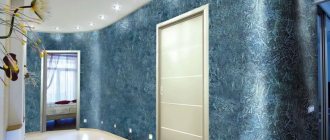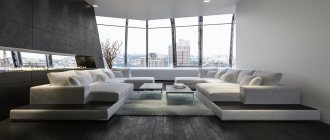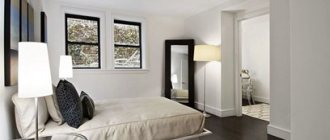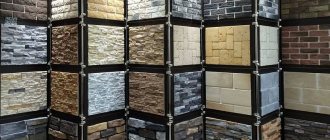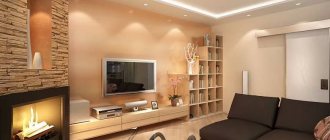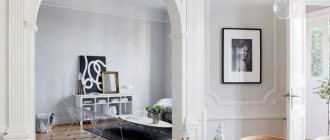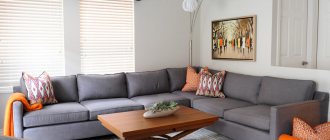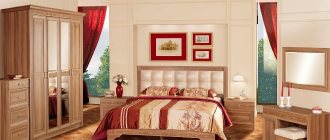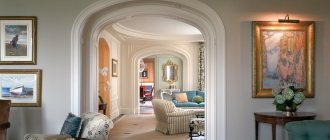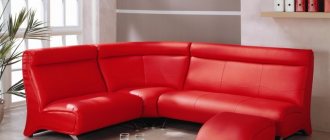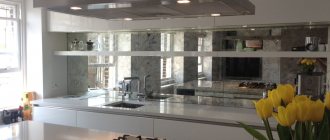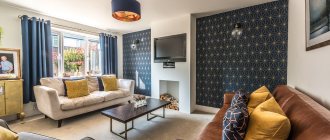Photo: interiordesign.net
American
You can use American-style lining, or “American”, in the interior. Although it is used more often for exterior decoration, as it is laid overlapping and effectively protects the walls of the house from precipitation.
Photo: wolfweyr.com
More information about types of lining
On the modern market of finishing materials you can find coatings made of wood, plastic and metal.
The most popular, of course, is wood siding, which is environmentally friendly, provides additional thermal insulation and looks great. Since wood siding is the most popular, we will talk about it in more detail below. The second most popular option is plastic lining. Conscientious manufacturers use high-quality plastic for its production, resistant to various negative influences: low and high temperatures, high humidity, and so on.
This coating is perfect if the room has a constantly high level of humidity. Most often, plastic siding is used on balconies, loggias and bathrooms. In some cases, external finishing is possible.
Metal cladding is not in great demand, but it is also used for finishing some rooms and external cladding of various structures. Metal panels are the most durable, so their scope can be very wide. However, due to its unpresentable appearance, such a coating is not used in all works.
Types and advantages
The lining is represented by the following materials:
- Wooden from natural wood (larch, ash, beech). Moreover, the cost directly depends on the classes (from “0” to “C”). A hidden advantage is the unique opportunity to use the cheapest possible variety if the design does not provide for an ideal surface (rustic, chalet), and stains and other color defects are easy to paint over.
- MDF. Made using the gluing method, it is still a “wooden” material that retains its presentability, but slightly loses in quality characteristics: first of all, it must be protected from moisture.
- Plastic. The cheapest, just an imitation of appearance, not carrying the semantic load of natural materials.
In terms of external appearance, it differs even more: from “American”, imitating overlapping boards, to a block house with its log texture. For those who want to achieve not only external harmony and elegance in their home design, but also to comply with the conditions of Feng Shui, as if a “soft line” variety with rounded chamfers was specially created.
There are a number of advantages for the design of premises, and the most important ones are those that improve the comfort of human existence:
- long service life;
- environmental qualities;
- healing effect of natural wood species;
- low susceptibility to dirt and dust;
- heat and sound insulation;
- resistance to humidity, high temperatures;
- no significant installation costs.
Aesthetic components that provide leading design positions:
- The ability to change color by painting: this can be done more than once during use.
- Adjustment of the visual geometry of space. Vertical arrangement - stretching, adding height, horizontal - adding volume, stretching the perimeter of the room.
- Combination with most modern materials: tiles, stone, porcelain stoneware, tiles, textiles, glass, leather.
For renovation of any premises, technical simplicity of execution is a plus not only in optimizing time costs, but also financial ones. There is no need to pre-prepare the walls for the lining - it will do an excellent job of masking unevenness on its own.
Types of lining profiles
Manufacturers produce different types of profiles, which differ in the type of locks, the size and shape of the back and front sides, and the type or type. If you are planning to decorate the interior of your car, it is better to choose the design of the room in advance - this will help you decide on the selection of the profile.
Standard class plate is often suitable for indoor use
Standard. The basic profile is trapezoidal, with the front side parallel to the back. There are two cross cuts on the back to prevent transportation. One of the edges of the rail is equipped with a corner, the other with a protrusion, together they form a “spike groove” type connection.
Eurolining is one of the most popular types of lining
Eurovision. They are distinguished by the presence of a corner connection and a longer “shelf”, thanks to which the joints between the panels are more noticeable. The home's interior features European millwork, which benefits from the clever design of the spires. There are vents at the rear of the track that are designed to detect excess moisture and prevent crown formation.
The smooth lines of the Softline car distinguish this type of profile from others
A fine line. This type of implant has rounded corners, which reduces the likelihood of runs and netting. But due to the elongated “shelf”, the seams between the panels are very noticeable. Softline Carrier is recommended to be used to decorate bathhouses and canopies.
“Brick” panels are widely used not only for finishing bathrooms and saunas
Calm. The characteristic profile of the profile is the absence of a bevel at the tenon, which makes the joints almost invisible after installation. The effect was used for cladding the façade to simulate “under bruises.” This allows you to increase the thickness of the panels - up to 25 mm.
The Calm Button is one of the most popular profile types.
Landxayc. One of the most expensive types of profiles, since their front side is subject to additional processing to create complex options. Also, using hot stamping you can get a panel with the effect of wood carving. A Landheads vehicle was used for interior decoration of the premises.
Blockxayc. The front side of the profile is rounded, which in its finished form will create the effect of wrapping cylindrical logs. Most often used to decorate the facades of buildings.
Imitation “under a cylindrical barrel” allows you to create original interiors
America. The main difference between the profile is that the back and front surfaces are not parallel to each other. The difference in thickness can be 6-8 mm, and the slope can be 5 degrees. 3a this creates the effect of installing boards on the outside or simulating cladding with siding panels.
American
Painting rules
Coating panels with paint consists of several stages, the strict implementation of which will ensure a long service life of the painted surface.
Stage 1. Boards are checked for defects, all damaged elements are rejected. Damaged boards are useful for testing shades and determining the number of layers.
Stage 2. Panels that have been sorted are sanded to a smooth state. It's best to use a sander, but sandpaper attached to a piece of wood will also work. The sandpaper should be 240-290 grit. Grinding is carried out in a circular motion, processing the front side, groove, tenon. The inner part does not need to be processed.
Stage 3. The coloring composition is applied using a brush or roller. A small amount of paint is distributed over the bar in short strokes, then shaded.
Stage 4. After uniform staining, the boards are left to dry.
Stage 5. When working with varnishes or paints of a dense structure, you need to sand the surface again.
Stage 6. Apply a second layer of the substance and leave to dry.
To preserve the wood structure, pigmented oils, glaze or wax are used. First, the coloring composition is applied in fragments over the entire length of the board, then the strokes are shaded with a brush and left to soak in for 7-10 minutes.
To reveal the grain of the wood, use a soft cloth to wipe off most of the oil coating. Due to this, pigment remains in the furrows, but there is almost no pigment in the convex places. In decoration, this type of painting is used for the interior surfaces of buildings.
Modern paints and varnishes allow you to achieve the effect of a two-color lining with a pronounced texture. For the first layer, take a dark shade, for the second – a more saturated or white one. Cover the board with the first layer, leave for 10-12 minutes, and then wipe off the excess with a lint-free cloth.
Leave to dry for a day. Then cover with light-colored oil, after 10 minutes treat with a spatula, leave to dry for 24 hours.
Lining material and its advantages
At the moment, not only wood, but also its waste (MDF) is used for the production of cladding. Plastic models are also popular, attractive with their colors and low cost. We invite you to familiarize yourself with each of the options, which will allow you to choose the optimal solution, taking into account the properties and main characteristics of the materials.
Wood
The wooden carriage has found wide application in both external and internal decoration. The room, upholstered with a carriage made of natural wood, looks attractive and is easy to breathe in. The material is suitable for upholstering walls, for decorating a canyon or a bathhouse. But for rooms with high humidity, it is important to choose the right type of wood - only in this case will it last long enough.
Natural wood fills the house with a natural atmosphere
The wooden cart consists of the following types:
Pine is a light and resinous wood that has bactericidal properties and is resistant to pests and scales. Suitable for interior decoration of residential premises; for these purposes it is better to take a dryer, which is prepared in winter. It is not recommended for use in a bath, as resinous compounds are formed at high temperatures.
The ideal choice for the bedroom is pine.
Spruce is a tree similar to pine, but has a lighter shade. In the sun's rays, the coating quickly darkens, so the spruce machine is more suitable for dividing rooms, it is good for the rest of the day. A distinctive feature of wood is its high resonant properties, due to which the material is often used to decorate sound recording rooms.
Lightweight dry wood suitable for carpentry
Fir is a material that is often sold as spruce or pine and is difficult to distinguish by color. But there is more resin in a letter than in a spruce machine, and there is much less resin. The material retains its bactericidal qualities for a long time; it is excellent for decorating a balcony, house, veranda or loggia, where they are often found in other cities.
Excellent reliable characteristics make the letter an ideal material for decorating a loggia
Dub is renowned for its robust features. The wood tone is painted into the center of the dock, providing great design opportunities. But it is not recommended to divide the interior with a double wall - it will be too sentimental. Keep in mind that mold and rot rarely throw the cart out of oak, and wood is very easy to infest with insects.
Oak Wagon is one of the most useful separate materials
Sheet is one of the most reliable materials, which is not afraid of insects and is little affected by the brake. Thanks to its exquisite texture and wide range of colors, wood allows you to achieve an interesting effect in the interior. But if you select it based on the shadow, you can select it based on the shadow. Pepebird is much cheaper. The resin content in the material is high, but it comes out in a short time.
The high aesthetic properties of the cart crossbow justify its high price
Birch is the raw material for creating light and the aesthetics of a beautiful table. Its advantage is that the car is resistant to direct sunlight. But there is something less: wood is easy to free, so it can only be used in dry, warm and well-ventilated areas.
Birch groove looks attractive, but don't make any effort to resist bending
Ocin, alder, linden - their wood is suitable for cutting the core of their premises: the reason is poor mechanical safety. But the carriage of these tree species is widely used for lining saunas and canyons, as they emit high temperatures that are beneficial to health.
The carriage-covered attic provides a warm and welcoming atmosphere
MDF
The material only indirectly belongs to the category of wood: the raw material for making a car from MDF is inconspicuous wood waste or wood dust. After special heat treatment of the materials, the space will take up a lot of space, and the light weight and acceptable environmental characteristics will allow you to take advantage of this space.
The service life of an MDF car is not so long that it can be compensated for by a number of facts
The key advantage of the material is its wide range of colors, which will allow you to perfectly reproduce different images and facts. Manufacturers produce profiles imitating marble, stone and other materials, expanding design possibilities. I can popularize an MDF car by buying drivers with a small budget for repairs.
Large selection of cars in different colors and colors to suit the consumer's eye
Plastic
Plastic profiles or ATS panels fit well with wooden counterparts due to their low cost, ease of installation and durability. The plastic machine is suitable for both internal and external cladding - the panels can be used in any room. In this case, it is necessary to understand that the aesthetic characteristics of an automatic vehicle are much lower than its wooden counterparts.
Auto Plactikova: the ideal solution for covering a balcony or loggia
When choosing to use plastic panels, keep in mind that the material does not work at high temperatures and is easily deformed and burns out. Recommended for use in rooms with high humidity, such as in a bath or on a balcony.
Shiny plastic panels look attractive, but quickly lose their shine.
Features of the material
Lining is a cladding material consisting of thin boards equipped with connecting elements along the side edges - a protruding tenon on one side, and a groove on the other. This design allows you to assemble fabrics of any size from the lining and finish any planes and surfaces.
The front side is smooth, can be flat or slightly convex to imitate rounded log masonry in a set. There are many design options for the front surface, which allows you to choose the most suitable option.
Initially, lining was used to cover the walls of carriages (hence the name). However, the convenience and high speed of installation quickly expanded the scope of application of the lining. It was used for finishing construction sheds, brick or concrete surfaces that require insulation.
The specific appearance of the material became the reason for the unanimity of designers who used it to decorate camp sites, hunting lodges, and country houses. In addition, the low cost made it possible to decorate construction cabins, trailers of geodetic or geological field camps with clapboard. This also influenced the perception of the material, making it not so much a decorative as a functional type of cladding.
The modern approach to lining has changed dramatically. A new generation of designers has grown up, unfamiliar with the realities of the Soviet era. They don’t have any associations when they see the material, which gives them the opportunity to see the potential and previously hidden capabilities of the lining.
In addition, new trends in the style of room design go well with the specifics of the cladding, and the ability to combine the functions of insulation, sound insulation and decorative material is regarded as a great advantage.
How to use lining for finishing
There is no single classical finishing method. Due to the versatility of wooden boards, they are used both for finishing walls or ceilings, and for decorative purposes.
Ceiling
If you want to diversify your interior, and suspended and simply plastered ceilings look banal, lining is your option. This coating is quite inexpensive, but requires special treatment to ensure its durability. Cover it with a special compound that will protect the coating from burns and moisture.
Walls
Some people believe that decorating walls with wood is only suitable for private houses and cottages. On the one hand, the closer you come to nature, the more natural the wood paneling will be. In addition, natural styles are often used in the design of summer cottages and country houses - country, chalet, Provence. Wood looks harmonious in them.
On the other hand, no one forbids giving the apartment the charm of a dacha. For urban conditions, a painted coating is most suitable. With its help you will create a unique and cozy interior.
In the photo there is yellow upholstery in the bedroom behind the headboard
Window slopes
Plastic slopes reduce the cost of finishing and are not suitable for all interiors, so in the interior of apartments and houses they often resort to finishing windows with lamellas.
The panels are attached in two ways: on the lathing (the same option is used for walls and ceilings) or on foam plastic.
For zoning
Zoning a room is an important part of creating a competent interior. And one way to highlight an area in a room is to use different finishing options. For example, wood panels painted in different shades of brown were used in this living room to cover the walls and ceiling of the sitting area. Their combination with the dark gray walls of the main area looks elegant and impressive.
Photo: Instagram corp_snab
As a decorative element
From lining you can make unusual decorative elements for any room - be it a living room, a nursery or a bedroom. For example, in this apartment they decided to decorate the walls of the children's room with mountain peaks.
In this living room, the upholstery is made in the form of panels on the wall behind the sofa and the same decor on the ceiling. Special wood treatment gave the effect of aging. This adds a certain charm to the interior of a country house.
But the upholstery was used to decorate the TV area in the bedroom. It was laid diagonally to highlight this section of the wall.
Furniture finishing
An unexpected use of upholstery is in decorative elements of furniture. For example, part of the bed was made of wood panels.
When choosing a material for wall cladding in any room, always pay attention to its advantages and disadvantages and study examples. We have prepared for you a summary table of the pros and cons of the finishing coating.
Advantages and disadvantages
| Environmental friendliness. Since siding is a natural material, it can be used in residential areas. | Not a very easy installation: If the walls are concrete, you will need to grind the wall. |
| Availability - the price of the coating is low compared to analogues available on the market. | Low moisture resistance - special treatment required. |
| Possibility of finishing - it is easy to paint the upholstery in any color and make the interior more interesting. | Fire Hazard: All wood burns easily. But you can protect your home by covering your siding with special compounds. |
| Relevance: upholstery is always in trend. Especially now, when they began to use it in almost all styles: from Scandinavian to country. | It's difficult to replace upholstery - it's not wallpaper or paint. Replacing this coating will require more effort. |
Execution options
In addition to standard placement methods: horizontal and vertical, over the entire surface, there are several more design techniques for lining arrangement:
- Diagonal. It will provide dynamics in the interior, as an accent on the wall or ceiling, but will require more painstaking work.
- Alternating multidirectional stripes. Giving a special, exclusive charm using various patterns: herringbone, steps, bricks and all sorts of combinations of these methods. The high cost of the method is more than compensated by the individuality of the final result.
- Only the lower third of the wall surface is decorated, the upper part is decorated with wallpaper, paint, and the border is decorated with molding. In addition to financial benefits, you can get a unique interior.
- An excellent option would be to create a panel, another fragment of an original shape on one of the walls, which can become a significant interior accent.
Options for room design using lining
A modern approach to interior design, combined with a new look at the possibilities of cladding, allowed designers to develop many solutions. Today, this material is used for cladding not only walls, but also ceilings, used in residential premises and decorated in different styles. There are design solutions where the coating acts as a floor covering, albeit for a small part of the room.
An effective use case is to lay the slats horizontally. The canvas has an unusual and very elegant appearance, providing an unusual and attractive surface appearance.
At the same time, it is not customary to cover the entire room with clapboard. Only one wall is cut out (very rarely - two adjacent ones, if their total area is small). Most often, only a small section of the plane is sheathed: they create a decorative panel above the head of the bed, create a platform for hanging a TV, separate a section of the ceiling slab for installing a chandelier (or group of lamps).
Many users look at the interiors of different rooms - what the lining looks like in the bedroom, kitchen or living room.
However, it is more correct to take into account the laying technique, type of processing and size of the canvas. This determines the decorative effect and allows you to create sections of walls or ceilings that attract attention and decorate the room, regardless of its purpose.
Living room
The coating goes well with wallpaper. If you make a panel at the bottom of the wall, the room will turn out to be especially cozy and welcoming.
Everyone is already tired of boring, monochromatic living rooms. Let's add some color to the interior using lining and play with contrasts? For example, you can trim the walls with clapboard and paint them in an unusual color (complex dusty shades look most interesting, as in the photo above), and leave the floor or ceiling white. Fresh and unusual. The reverse scheme also works: light wallpaper - snow-white lining.
Kitchen
This material can be used in kitchen decoration: both on the walls and on the apron. Of course, when laying the cladding in the work area, you need to take care of additional processing of the wood. This coating will fit into a modern kitchen design and will withstand country style.
Inside the kitchen, you can cover everything with clapboard or just focus on the dining area. The lining also looks beautiful on a kitchen apron. Do you want problems with cleaning? Treat with an antiseptic and coat with moisture-resistant paint.
In a country-style kitchen, an untouched coating looks harmonious; in other cases, it is better to paint it. For the Scandinavian direction, white, gray and beige colors are suitable, for Provence - delicate pastel colors. For a sustainable look, choose brighter shades such as green or brown.
Hallway and corridor
In panel houses, corridors are often narrow and uncomfortable; Horizontal paneling of short walls will increase the space and make it more pleasant. On long walls, attach the slats vertically or diagonally. The panels look interesting: for example, from the boards you can create the outlines of mountain peaks or a city landscape.
An added bonus in the hallway: you won't need special hardware to hang an extra hook or shelf.
Children's room
The use of environmentally friendly materials is especially important for children, so wooden panels come first. In addition, its variability and ease of processing allows you to create extravagant patterns on the walls and ceiling, which is a plus in the design of a nursery.
Bedroom
The most effective placement of upholstery on a bedroom wall is behind the bed. Accentuate a wall or adjust the geometry of a room with matching stripes.
An interior with a natural tone board in a bedroom with white furniture looks fresh and will remain relevant for many years.
The photo shows a country style bathroom design
Balcony
Wooden panels are very popular for decorating the walls of balconies. Budget-friendly, stylish, can be varied with paint - these are the factors that determine such a high demand for this material. Also, designers often use lining in the design of balconies and loggias.
Bathroom and toilet
Wood materials have low moisture resistance - that's a fact. But thanks to special impregnations, they can be used for finishing walls in wet rooms, for example, in bathrooms or toilets.
Lining in different interior styles
Country, Provence - these are the styles in which the lining feels absolutely in its place. Wooden accents in the interior add warmth and comfort and blend harmoniously with aged wooden furniture. But the lining easily fits into more formal interiors. Here are some examples of how you can neatly fit lining into the space of a modern home.
The outer wall in the photo above, covered with clapboard, also serves as a wooden accent and has a purely utilitarian function of additional thermal insulation for the bedroom.
The clapboard ceiling looks organically in the space of a modern loft. This technique visually lowers the ceiling a little, which is what the designer of this project actually wanted to achieve.
A wall panel assembled from artificially aged cladding boards looks great.
How does installation work?
Everything is in order.
The order is completed. Without it, channels appear where moisture accumulates, moisture rises in the room, fungus may develop, and the wall will begin to rot. Therefore, repair work is carried out according to all rules. Even if the walls in the house are perfectly smooth and made of wood yourself, before covering the wall with clapboard, you need to install the sheathing.
Forced ventilation ducts are installed in clapboard wall decoration (they are specially cut from boards). No turning anywhere. It should be made of wood, just like the panels. This is important because the material acts as a shock absorber. This is especially important when using minimal materials on the walls. The spaces (deformations) between the wall itself and the boards perform the same function. Connectors have a diameter of 5 mm or more.
For example, it is not uncommon for wooden boards to be placed on steel sheathing (for example, when installing drywall). After a short time, the material begins to expand and cracks appear. But after removing the baseboards a few years after installation, it turns out that the smooth surface of the wood lathe is only slightly worn around the edges. Whatever type of turning it is, the basis for its installation is the same for everyone - the turning strips should be placed strictly perpendicular to the boards.
Don't forget about the bars around the edges:
- The ends of the boards should not hang down;
- When installing the cladding diagonally, its sheathing must have a frame (solid);
- The thickness of the planks is from 20 mm, width - from 30 mm;
- The size of the beam installation step is at least 4 boards wide;
- At the ends, the attachment points are placed at a distance of 50 mm.
Types of installation
Of course, before you start covering the walls with wooden boards with your own hands - an example in the video, you need to decide on the type and direction. Be it horizontal, vertical, diagonal, herringbone, diamond or brick, mixed.
Horizontal installation is considered a classic (in Russia this is true). It has a positive effect on expanding the space of the room. A small drawback that can be avoided (when installing the grooves are directed downward) is dust and moisture that accumulates at the joints of the boards. Following this recommendation, start styling from the top.
Vertical placement is most popular among Finns. Makes ceilings higher. This effect is especially important for low rooms. Installation of wall decoration with clapboard begins from the most difficult angle.
Diagonal (and mixed) installation is distinguished by directionality and aesthetic appearance. Installation is much more complicated than previous options. The interior, decorated with wood of different species and shades, looks especially bright and unusual.
It is easier to install wooden panels on walls horizontally using planks or vertically.
The vertical version of clapboard cladding is simply necessary for rooms with high humidity, places where frequent condensation is possible (bathroom, kitchen, etc.). Since the horizontal method will not protect from excess moisture. The type of installation, when installing boards vertically, determines whether the tongue and groove will be cut, in what place, and for how long.
When installed horizontally, the end result looks very attractive. Here the lining is installed, pointing the ridges upward to protect the grooves from water accumulation. This will prevent the appearance of rot, microbes, and fungus in the future. When installing the first bottom panel, the side of its groove is cut off. This removes the pocket that will collect moisture.
The least used option is the diagonal siding placement option. It is more difficult, with a lot of material waste. From the point of view of beauty, it is practically no different from previous installation methods. Decorating the walls with clapboards with your own hands will add zest to the room.
There are shaped styles: herringbone - a little difficult, but possible. A vertical sheathing is required on which the pieces of material cut out according to the template will be attached.
A more complex lining is wall lining in the shape of a diamond. The rotation is made in the form of a cross in a frame. The rods are attached diagonally in its quadrants. The work that goes into installing diamond pavement is well worth it. The result looks incredibly elegant and expensive.
Choosing the method of installing the lining
There are three ways to attach the cladding to the walls: glue, nails and clamps. The choice depends on the operating conditions and the condition of the walls.
You can stick the lining in a dry room on smooth walls. If it is thin (13-15 mm) and small in width (80-100 mm), this can only be done with glue. For larger sizes it is better to secure it with your nails, but you will need 30% less.
Wall cladding is not boring at all. This is an ideal finishing option for a wooden house.
You can also glue the coating to relatively flat walls, but only minor deviations are allowed. This trim panel is not very thick and will bend, but due to the natural elasticity of the wood it may tear into voids. Therefore, if the walls are not perfect, it is best to use a combination of glue and nails.
Types of cladding and accompanying profiles: Standard, Shtil, Eurolining, Softline, Landhouse, American, Blockhouse, Double-sided
Nails or screws can be used to attach the cladding either directly to the walls or to a lathe. The second option is chosen due to uneven walls or the need for thermal, acoustic and moisture insulation. Nails can be driven into a tenon, groove or face (photo below right). The first option is called secret, the second - traditional. It is impossible to apply any coating to the tenon/groove, but only some types of it (with sufficient protrusion/recess dimensions). And this option is also only available for dry residential premises.
Methods of fastening the lining: with clamps and self-tapping screws
Clamps (or strips) are special fasteners for hidden installation of corrugated moldings (photo above left). Some types of cladding fall into this category. If the material you choose has a large, strong tongue/spike, it can be secured with clamps. These mounts are usually attached to the lathe, but are also possible on a plywood wall.
How to create a sheathing for fastening lining
Preparing walls for cladding is the most painstaking process. You'll have to tinker with creating a custom design. General recommendations:
- Treat the wood with fire-resistant impregnation and antifungal agents.
- Make sure that the slats are positioned strictly perpendicular to the decorative boards.
- it is necessary to maintain a uniform distance between the rails, the pitch of which is 40-50 cm.
- Leave some space between the floor and ceiling. This recommendation is especially relevant for wooden houses that are constantly subject to shrinkage.
- It is necessary to carefully check the uniformity of installation of the frame; for this, use a plumb line and a spirit level.
- If a gap has formed between the slats and the wall, then it must be filled with prepared forms.
Important! The design of the machine allows you to equip the walls with an additional layer of insulation. Insulation is attached between the formed racks.
Choice of material for the frame
The frame for cladding mainly consists of two types of material - a wooden block or a metal profile.
Wooden block. The most popular material for the frame, because it is easier and faster to attach the sheathing to it. Suitable for dry rooms, for walls with minimal humidity. It is used not only in the interior, but also on facades. A cheaper option than a metal frame.
Metallic profile. Also a reliable frame option. The same metal profile is used to assemble frames for drywall. Suitable for any type of room. However, due to the high thermal conductivity of metal, it is necessary to take into account how cold the walls are. From a cold wall, the metal profile will transfer more cold to the front surface of the wall.
frame made of metal profile
As in the first case, in the second case it is recommended to insulate the walls inside the frame with special materials to fill the gap between the rough surface of the wall and the lining.
Calculation of material for sheathing lining
To calculate the required amount of timber or profile, you should decide in which direction the platband will be mounted.
The cladding is mounted in four directions:
- Vertical
- Horizontally
- Diagonally
- Mixed method
Find out more about these areas below in the article.
vertical, horizontal and diagonal slats
The most optimal step on the wall, between frame profiles (bars) should be from 40 cm to 60 cm. A profile must also be fixed along the perimeter of the wall or ceiling; this should be taken into account in the calculations. Having measured the dimensions of the sides of the wall or ceiling, taking into account the step between the rotary strips, draw a grid of your frame on paper and calculate the total length of the profile (beam) you need. Metal profiles and strips are always bought and sold in specific sizes from 1.5 meters to 2.5 meters depending on the manufacturer. Dividing the total length of the material by the length of the profile will give you the required amount of material.
If the profile is installed on hangers, then their pitch along the entire length of the rod is also from 40 to 60 cm. As a result, a rod 240 cm long will require 4 hangers, when installed with a pitch of 60 cm. For each hanger, 2 to 4 dowels are required , if you are attaching the frame to a stone wall. And from 2 to 4 wood screws for attaching the rod to the hangers. To secure a metal profile to hangers, you need to purchase metal screws, which are commonly called “bugs.”
Some laying rules
In order not to spoil the finished repair, certain rules are followed when installing the coating:
- Do not install directly on damp and porous walls or sheathing;
- The wall must be properly prepared;
- The best option is cement plaster;
- If the room is dry, then the walls are smooth and plastered - the bars are fastened with EU staples (used for drywall). These are perforated plates.
To ensure that everything was done expertly, the smoothest bars were chosen. The brackets are attached to the walls, the central plank is installed (placed first), along the edges of which the brackets are folded, and the ends of the plank are fixed. Next comes the bending of the intermediate brackets, the bar is completely assembled (without deformation). Subsequent planks are aligned along the central one, located precisely in this plane.
The safest way to prepare walls for cladding is to make a vapor barrier. For some rooms this is extremely necessary (kitchen, sauna, corridor, etc.).
Do-it-yourself clapboard wall decoration requires maintenance.
The wall must be completely flat, the insulation on top must be foil side out. The insulating material (on a special tape) is laid with an overlap (15 cm). Next comes the fastening of plywood siding (of the required thickness, at least 8 mm) to the wall under the bars. Then the rotating beams are attached to them.
This results in a well-ventilated space gap (between the lining and the insulation).
The basic principle of laying the coating is to start work from the most difficult small areas; ending with large, simple sections.
When the wall is already covered with clapboard, the baseboards are fixed. Covering walls with your own hands helps you save a lot and find interesting solutions. An analogy with laminate is appropriate here.
Coating
The final step is to coat the wood with special varnish and varnish compounds to give the material an appropriate shade and enhance its performance. For this purpose, several types of paint and varnish coatings are used:
Applying paint improves the aesthetic characteristics of the car
- Alkyd lasts for a long time, has a sour and unpleasant odor, but perfectly protects wood from moisture.
- Acrylic - quickly saves, due to which it is often used for indoor work. Attracts attention with a wide range of colors, well conveys the temperature range and the influence of humidity.
- Water-based paint is environmentally friendly and safe to use. It sits down quickly, there is practically no click. The main disadvantage is the high cost.
- Polyurethane is a universal coating that prevents wood from yellowing. Has rich translucent shades.
The sanded surface is processed after two to three cleaning cycles after installation is completed. The paint is applied in two layers: before applying the second surface, the tops are sanded to eliminate errors.
How to calculate the required amount of paint
Any repair or construction must begin with an estimate and detailed instructions. Consumables, such as paint for lining, must be purchased in reserve. When making calculations, one should take into account the characteristics of the surface, tools, professionalism of the work performers, the number of layers and the texture of the mixture.
If the entire room is to be painted, then first of all it is necessary to determine its perimeter. We take away the area of doors, windows, openings and other untreated surfaces. The result obtained must be compared with the standard consumption of the selected type of paint. Manufacturers place this information on the product label. You need to understand that the quantity is indicated taking into account the work under ideal conditions, for one layer of painting.
What nuances should be taken into account when working with lining
Sheathing is a board of varying thicknesses made from different types of wood. This material got its name from the place where it was first used. These are train cars whose interior walls are lined with small wooden boards. Today it is fashionable to cover the walls with boards in the bathroom, as well as in the sauna or gazebo.
It should be borne in mind that decorating walls with clapboards with your own hands requires an integrated and balanced approach. Please pay attention to the following details:
- Packaged cards should be stored horizontally on the mat.
- The humidity in the warehouse should be within normal limits.
- Do not store in direct sunlight on the packaging.
- It is important to pay attention to the expiration dates indicated on the packaging.
- The cost of 1 m2 of distilled linden, which can easily withstand temperature changes and high humidity, costs 500 rubles, and for wall cladding in the main rooms of the dacha, on average, you can leave a smaller amount - 300 rubles per m2. Important! The price of the material directly depends on the quality of the wood.
On a note! Wall cladding is purchased with a reserve of ten percent of the total area. It should be remembered that the width of each element is measured by the internal depth, so it is necessary to subtract 10-12 mm from the depth of the groove.
Painted lining
An interesting way to use wainscoting in your interior is to paint it.
Paint the clapboard walls white and soft blue for a great nursery in a Mediterranean or Provençal style...
...paint it a soft yellow for a great backdrop for a country style room.
A white wall made of painted and artificially aged lining fits well into the interior of a Scandinavian-style bathroom (although, in our opinion, it is not entirely comfortable in the bathroom)…
... and into the space of the large kitchen-dining room, echoing the same textured furniture facades and wooden ceiling.
There is old clapboard on the walls. How to clean it? Restore original color?
To do this, you can use a flat pumice stone or an abrasive wheel. As a result of sanding, the shalevka loses all its protective properties, which means it must be coated with an appropriate antiseptic solution, which not only plays a protective role, but also preserves all the properties of the paint.
Once the preparation is complete, the paint can be coated.
If you use classic paint, it will preserve the original upholstery pattern and will not require additional finishing. If the coating is opaque and completely hides the wood grain, to achieve an attractive and original look, you should take care of additional decorations, for example, elements for decorating windows and floors.
Preserving texture
It is possible to cover the lining with paint and varnish material without hiding its texture. To do this, you will need to treat it with oil with added pigment, wax or glaze.
Such compositions cover the surface well, softly envelop the wood fibers without hiding the natural pattern.
- Correct application of paints and varnishes involves fragment painting.
- In other words, using a brush, you apply a little paint along the entire length of the board, and then shade it.
- Afterwards, let the paint sit for a few minutes so that it is absorbed into the fibers.
- Remove excess with a cloth. This way you will receive the required invoice.
This technique is called texturing the material. Wood treated in this way harmonizes very well with the main interior.
Interesting ideas for using lining in the interior
Bedroom at the dacha clapboard
Varieties
Lining is a material that is produced by a huge number of manufacturers. In Soviet times, the quality of the lining depended on the type and type of wood used as raw material. Today, splice lines are used that produce higher quality material without flaws, knots or rotten areas.
The two main types - regular and eurolining - differ in the quality of the material and the presence of defects - since European quality requirements are stricter, eurolining looks much better and does not have the same shortcomings as regular material.
In addition, types of lining today differ in the shape and appearance of the front surface:
Blockhouse (imitated log wall)
American (laying boards overlapping)
Softline (in cross-section this is a regular eurolining, but with softened corners)
Calm (there is no deep chamfer along the tenon line, the connection of individual lamellas is more dense)
Landhouse (the relief of the front side has a figured element that makes the canvas more attractive)
Double-sided lining (there is no reverse side, the slats can be turned either side out)
In addition, the material is distinguished by grade. It is determined by the number of flaws on the front side of the lamellas. If the lining is made from blanks that have passed the splicing line, the quality automatically increases to the highest levels.
Attention! There are also types of lining made from MDF or plastic. These are wall panels that do not have a complete list of properties of wooden material and are used only for decorative purposes.
Frequently asked questions
Some questions that arise for untrained home craftsmen are exactly the same. You can answer them immediately, without waiting for them to appear:
When is it better to paint the lining, before or after installation?
Sometimes the material changes its linear dimensions slightly, and the gaps between adjacent lamellas become wider. If the lining is painted and finished before installation, such changes will remain invisible. This is especially important if dark colored fabric is used.
Is it possible to install panels with glue or do you have to use clamps?
Adhesive mounting can only be used when installing on a wall. Ceiling decorative panels have to be fastened in a more reliable way - with self-tapping screws directly through the slats, onto clamps, or a combination of several methods at the same time.
How to choose the trim color?
This is a purely individual question, determined only by the personal preferences of the home owner. The only recommendation would be to follow the basic rule - the larger the area of the cladding, the lighter it should be. This way it is possible to reduce psychological pressure and the dominance of the cladding fabric.
How dangerous is the cladding fabric in terms of fire?
The lining itself will not ignite. If there is a fire in the room, the canvas will burn, but it will never cause a fire. However, before installation, you can impregnate the material with a fire-retardant compound to prevent combustion.
Should the lamellas be glued together when assembling the canvas?
This should not be done. Despite the apparent strength and reliability of this installation option, the result will only be the impossibility of partially disassembling the canvas for repair or replacement of an individual element.
Popular self-processing options
Painted boards, of course, have a number of undeniable advantages, but the main drawback for many is its high price. This is often off-putting.
If you have at least some skills in this matter, then you can paint the lining yourself, thus saving part of the budget.
Popular formulations for treatment are:
- Varnish;
- Impregnation;
- Dye;
- Stain;
- Wax.
Varnishes create a translucent layer on the surface, with its help you can give the wood a noble shade. Impregnation and stain are invisible on the wall.
They are absorbed inside, protecting her. Often, another layer of varnish is applied to such a coating.
Paints create a color film on the surface, which often has good water-repellent properties.
The choice of composition depends on your goals and desires. To create a traditional interior, varnishes are used. Depending on the base element, they are divided into:
- Alkyd;
- Acrylic;
- Polyurethane;
- Scuba diving.
The most popular option is aqualak. It is versatile and non-toxic.
It can be used with equal success for both floors and ceilings.
Remember that it is better to apply several thin layers than one thick one. This will affect the quality of your work.
Alkyd varnishes are highly durable, but it is better to use them for facade work. They are very fragrant and take a long time to dry.
Polyurethane can be either urethane or acrylic based, or contain solvents. It is very abrasion resistant. But, alas, it releases many harmful substances.
Choice of finishes
Walls
Wall decoration in olive tones will set the mood in the interior; a warm shade creates a unique coziness. Dark olive walls in contrast with a light ceiling will visually make the room taller.
Wallpaper with floral patterns against an olive-colored background creates a rich combination. Playful patterns can be used in a child's room. You can also decorate one wall; this technique will designate the central place in the room, for example, a bed in the bedroom, a sofa or a fireplace in the living room.
The photo shows a bedroom in light olive tones with a floral print on the wallpaper, curtains and bedspread.
Advantages and disadvantages
The advantages of lining include:
- environmental cleanliness. The material is made from natural wood, completely safe for people;
- high thermal insulation abilities;
- simplicity and high speed of installation;
- the possibility of partial replacement of sheathing elements without the need for complete disassembly of the canvas;
- visual appeal, the possibility of finishing with various types of paints and varnishes;
- Possibility of use on internal and external surfaces, for cladding residential and office premises.
Disadvantages of the material:
- wood tends to absorb and release moisture, which leads to stress redistribution, warping, and bending of individual boards;
- wood is fire hazardous;
- the material rots, becomes covered with mold or mildew, which requires monitoring of operating conditions;
- the lining changes the volume of the room and creates conditions for insects or rodents to live under the cladding.
These shortcomings partially influenced the attitude of users, whose interest in lining in the 90s of the last century decreased significantly. And today, lining is considered primarily as an attribute of the design of a country house, although a lot of alternative solutions have appeared.
Expert opinion
Kukushkin Anatoly Sergeevich
Repair specialist
At the same time, the negative aspects of the material practically disappear if you use it creatively and under proper conditions.
Let's figure out the color
The widespread use of clapboard interior decoration is understandable; for Russia this material is quite inexpensive, an important factor is environmental protection, and the easy availability of the material. Under the profile, uneven walls and communications are easily hidden. But this type of decoration has one huge drawback - the impression that the room looks like a huge, red, wooden box.
Wood paneling initially implies variety. The decoration can be romantic, light and airy, or it can be elaborate and sophisticated. But before finishing it is worth getting rid of the vague yellow color. Alternatively, the board can be painted, but it would be more appropriate to whiten it, preserving the texture of the wood. The most important thing is to choose a shade that will look natural, but at the same time unobtrusive.
Do not rush to coat the panels with varnish to fix the color. Because it is precisely because of the varnish that the lining acquires the feeling of being in a dressing room.
In order to avoid a red tint in the decoration of their home, many consumers bleach the paneling completely. It's not very practical, and it also makes you feel like you're in a hospital room. In order to avoid this effect, you should breathe a little more life into the interior with the help of bright inserts. This could be: paintings, furniture, pillows, curtains and even decorative stained beams.
And vice versa, the same technique: an ash profile creates a contrasting effect in the smooth, bright white decoration of the bath. The use of wooden panels in finishing bathtubs is quite acceptable. If the ventilation functions well and the wood does not come into direct contact with water, then such a coating is acceptable.
